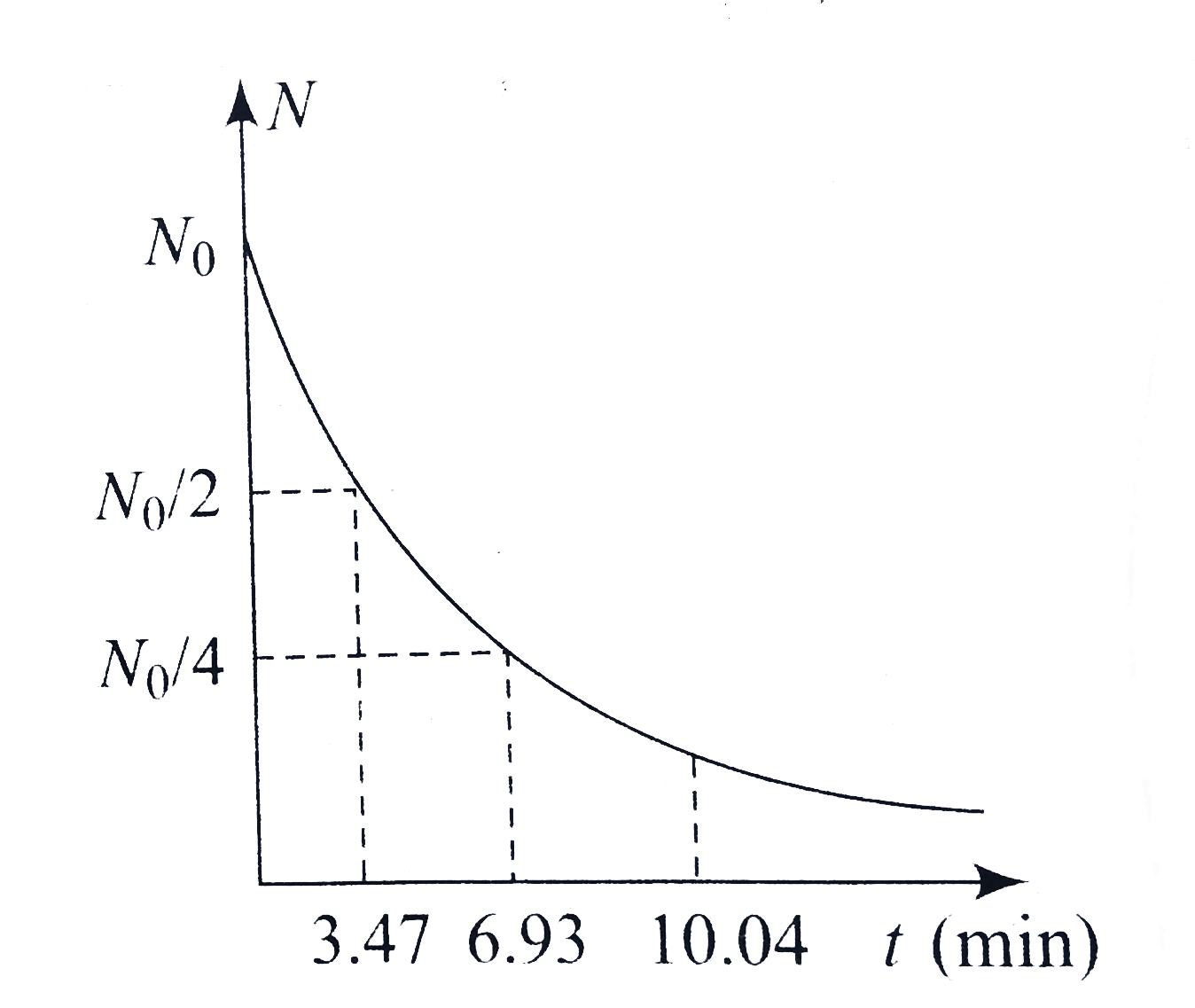A radio nuclide consists of two isotopes. One of the isotopes decays by α-emission and other by β-emission with half-lives T1=405s and T2=1620s, respectively. At t=0, probabilities of getting α and β-particles from the radio nuclide are equal . Calculate their respective probabilities at t=1620s. If at t=0, total number of nuclei in the radio nuclide are N0. Calculate the time t when total number of nuclei remained undecayed becomes equal to N0/2.
log102=0.3010, log105.94=0.7742 and x4+4x−2.5=0,x=0.594
The correct Answer is:A, B
To solve the problem step by step, we will break it down into two parts as described in the question.
Part 1: Calculate the probabilities of getting alpha and beta particles at t=1620s
1. Understanding Initial Conditions:
At t=0, the probabilities of getting alpha and beta particles are equal. This means that the initial activities of both isotopes are the same, denoted as R0.
2. Calculating Activities:
The activity of a radioactive substance is given by:
R=R0(12)tT1/2
For the alpha-emitting isotope (half-life T1=405s):
R1=R0(12)1620405=R0(12)4=R016
For the beta-emitting isotope (half-life T2=1620s):
R2=R0(12)16201620=R0(12)1=R02
3. Total Activity:
The total activity R at t=1620s is:
R=R1+R2=R016+R02
To combine these fractions, we can express R02 as 8R016:
R=R016+8R016=9R016
4. Calculating Probabilities:
- Probability of getting an alpha particle:
Pα=R1R=R0169R016=19
- Probability of getting a beta particle:
Pβ=R2R=R029R016=89
Part 2: Calculate time t when total number of undecayed nuclei becomes N02
1. Initial Nuclei Distribution:
Let N0 be the total number of nuclei at t=0. From the equal probabilities of decay, we can say:
N1,0=N05,N2,0=4N05
2. Undecayed Nuclei at Time t:
The number of undecayed nuclei after time t for each isotope is given by:
N1=N1,0(12)tT1=N05(12)t405
N2=N2,0(12)tT2=4N05(12)t1620
3. Total Undecayed Nuclei:
The total number of undecayed nuclei is:
N=N1+N2=N05(12)t405+4N05(12)t1620
We want to find t when N=N02:
N05(12)t405+4N05(12)t1620=N02
4. Simplifying the Equation:
Dividing through by N0:
15(12)t405+45(12)t1620=12
Let x=(12)t1620, then (12)t405=x4:
15x4+45x=12
Multiplying through by 5:
x4+4x−2.5=0
5. Solving the Polynomial:
Using the provided solution x=0.594:
(12)t1620=0.594
6. Calculating Time t:
Taking logarithm base 10:
t1620log10(12)=log10(0.594)
Using log10(12)=−0.3010:
t1620(−0.3010)=−0.5276(using log10(0.594)≈−0.5276)
Thus:
t=1620×−0.5276−0.3010≈1215s
Final Answers:
- The probabilities at t=1620s are:
- Probability of alpha particles: Pα=19
- Probability of beta particles: Pβ=89
- The time t when the total number of undecayed nuclei becomes N02 is approximately 1215s.
At t=0, the probabilities of getting alpha and beta particles are equal. This means that the initial activities of both isotopes are the same, denoted as R0.
The activity of a radioactive substance is given by:
R=R0(12)tT1/2
For the alpha-emitting isotope (half-life T1=405s):
R1=R0(12)1620405=R0(12)4=R016
R2=R0(12)16201620=R0(12)1=R02
The total activity R at t=1620s is:
R=R1+R2=R016+R02
To combine these fractions, we can express R02 as 8R016:
R=R016+8R016=9R016
- Probability of getting an alpha particle:
Pα=R1R=R0169R016=19
- Probability of getting a beta particle:
Pβ=R2R=R029R016=89
Let N0 be the total number of nuclei at t=0. From the equal probabilities of decay, we can say:
N1,0=N05,N2,0=4N05
The number of undecayed nuclei after time t for each isotope is given by:
N1=N1,0(12)tT1=N05(12)t405
N2=N2,0(12)tT2=4N05(12)t1620
The total number of undecayed nuclei is:
N=N1+N2=N05(12)t405+4N05(12)t1620
We want to find t when N=N02:
N05(12)t405+4N05(12)t1620=N02
Dividing through by N0:
15(12)t405+45(12)t1620=12
Let x=(12)t1620, then (12)t405=x4:
15x4+45x=12
Multiplying through by 5:
x4+4x−2.5=0
Using the provided solution x=0.594:
(12)t1620=0.594
Taking logarithm base 10:
t1620log10(12)=log10(0.594)
Using log10(12)=−0.3010:
t1620(−0.3010)=−0.5276(using log10(0.594)≈−0.5276)
Thus:
t=1620×−0.5276−0.3010≈1215s
- The probabilities at t=1620s are:
- Probability of alpha particles: Pα=19
- Probability of beta particles: Pβ=89
Topper's Solved these Questions
- MODERN PHYSICS - 2BOOK - DC PANDEY ENGLISHCHAPTER - MODERN PHYSICS - 2EXERCISE - Level 2 Comprehension Based
3 Videos
- MODERN PHYSICS - 1BOOK - DC PANDEY ENGLISHCHAPTER - MODERN PHYSICS - 1EXERCISE - Level 2 Subjective
23 Videos
- NUCLEIBOOK - DC PANDEY ENGLISHCHAPTER - NUCLEIEXERCISE - C MADICAL ENTRANCES GALLERY
46 Videos
Similar Questions
A radioactive material consists nuclides of 3 isotope which decay by α− emission, β- emission and deuteron emission respectively. Their half lives are T1=400sec,T2=800sec and T3=1600 sec respectively. At t=0, probability of getting α.β and deuteron from radio nuclide are equal. If the probability of α emission at t = 1600 seconds is n/13, then find the value of .n. is _____
View SolutionAt time t=0 , number of nuclei of a radioactive substance are 100. At t=1 s these numbers become 90. Find the number of nuclei at t=2s.
View SolutionAt time t=0 , number of nuclei of a radioactive substance are 100. At t=1 s these numbers become 90. Find the number of nuclei at t=2s.
View SolutionNumber of nuclei of a radioactive substance are 1000 and 900 at times t=0 and time t=2s. Then, number of nuclei at time t=4s will be
View SolutionA radioactive sample undergoes decay as per the following gragp. At timet=0, the number of undecayed nuclei is N0. Calculate the number of nuclei left after 1h.
 .
.
View SolutionA radioactive sample undergoes decay as per the following gragp. At timet=0, the number of undecayed nuclei is N0. Calculate the number of nuclei left after 1h.
 .
.
View SolutionA radio nuclide X is produced at constant rate α. At time t=0, number of nuclei of X are zero. Find
(a) the maximum number of nuclei of X.
the number of nuclei at time t.
Decay constant of X is λ.
View SolutionThe half life of a radio nuclide is 77 days then its decay constant is
View SolutionThalassemia and sickle cell anemia are caued due to problem in globin molecule synthesis . Select the correct statement.
View SolutionA radioactive element ThA(.84Po216) can undergo α and β are type of disintegrations with half-lives, T1 and T2 respectively. Then the half-life of ThA is
View Solution
